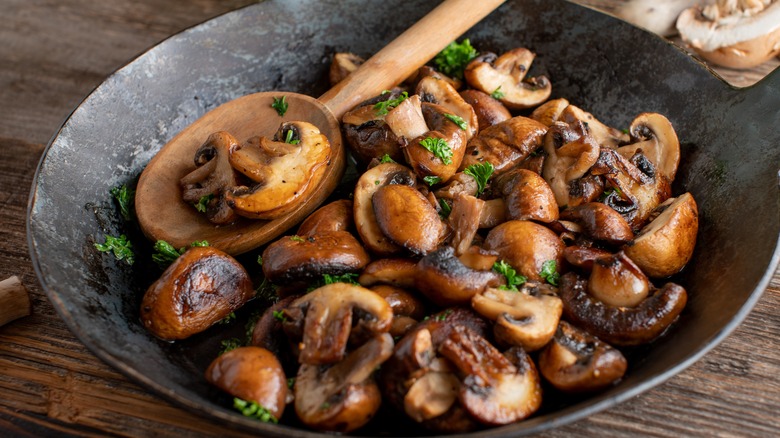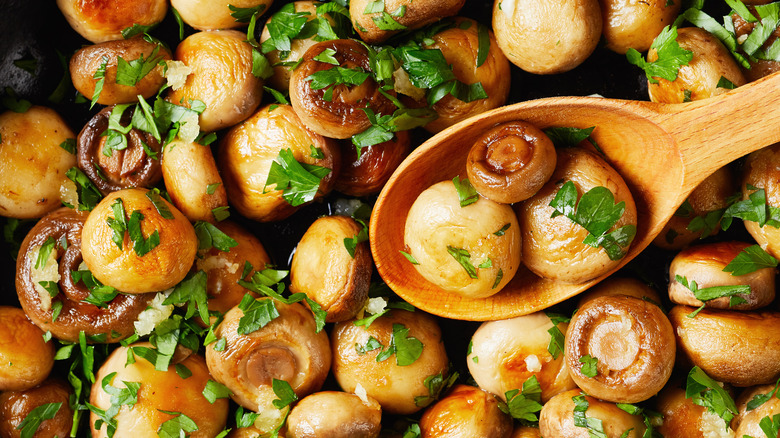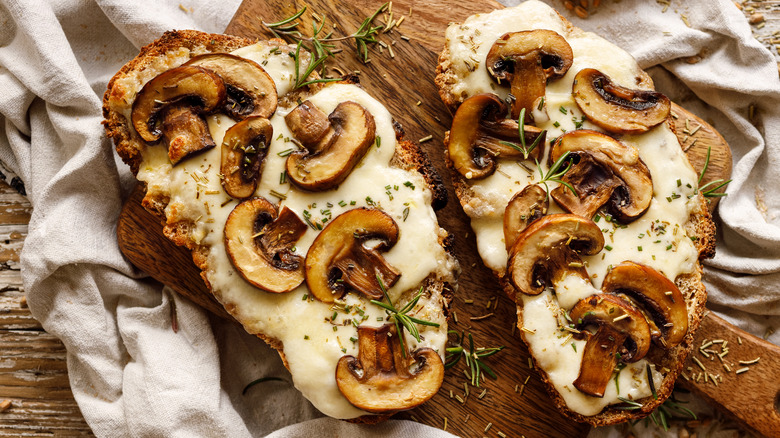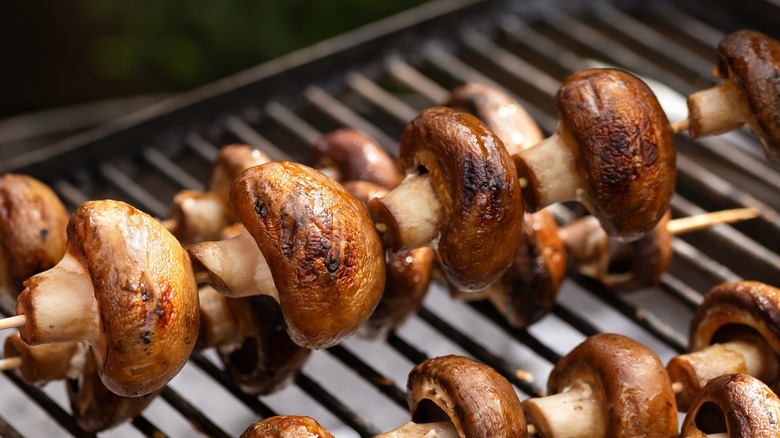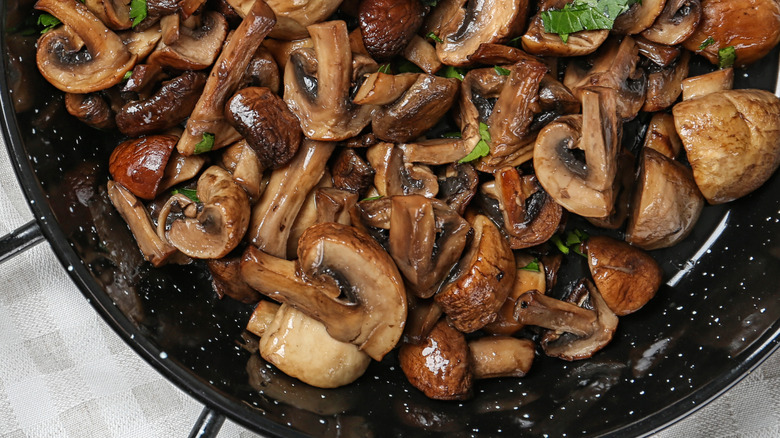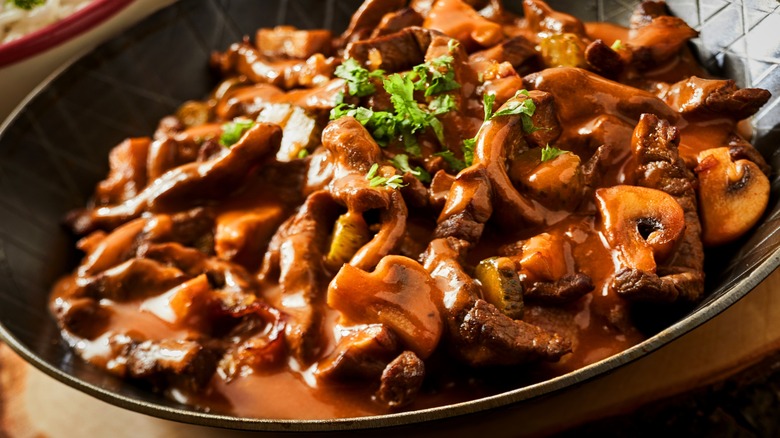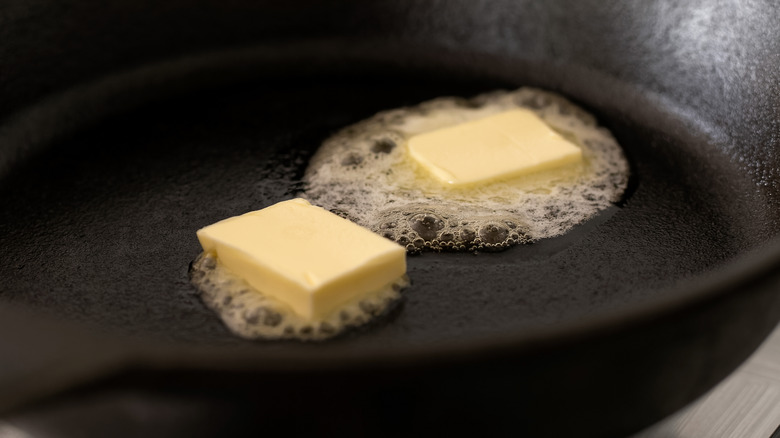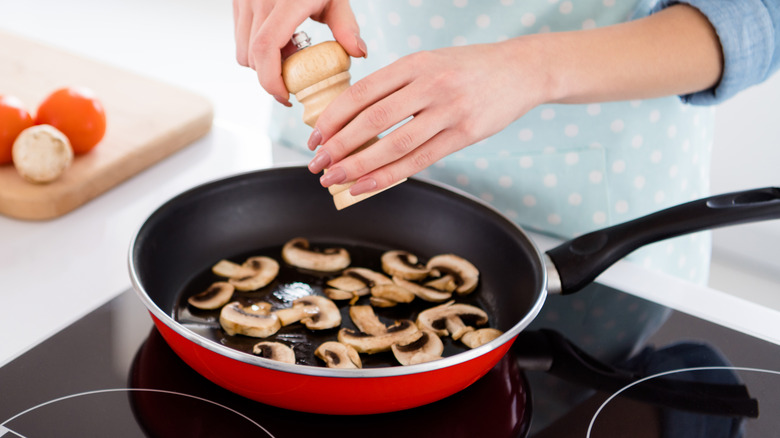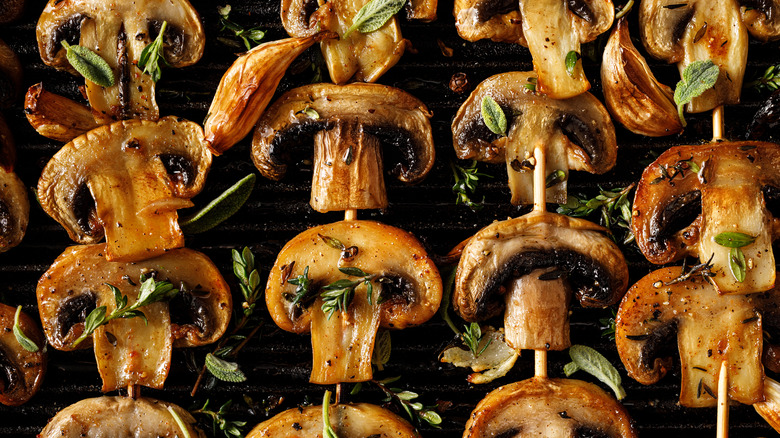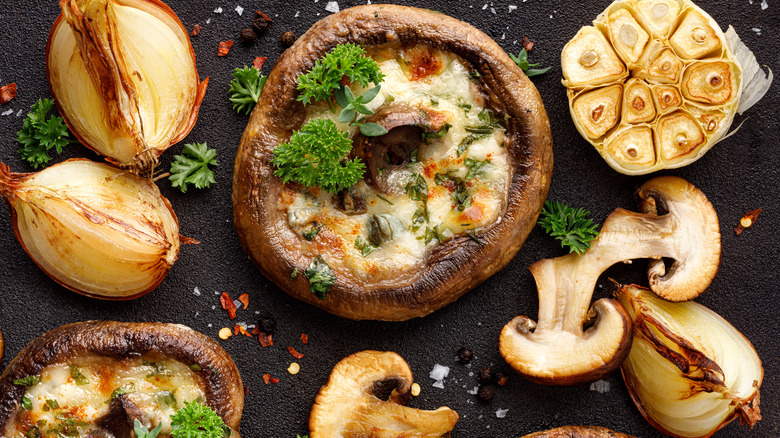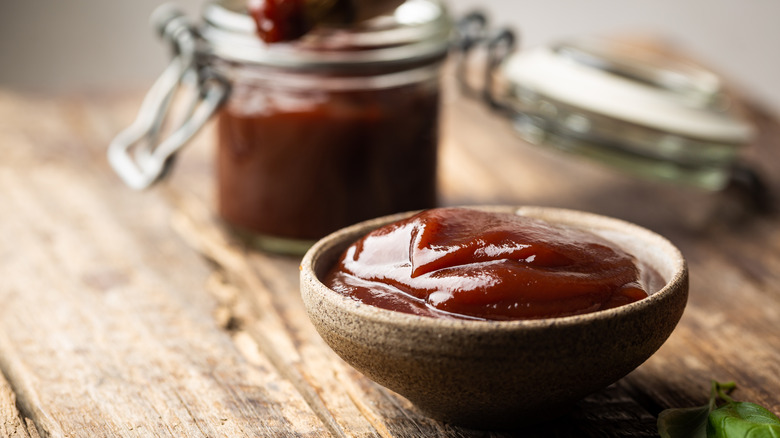10 Ways To Add More Flavor To Mushrooms
Mushrooms have a unique taste that adds unmistakable umami and savory notes to some of our favorite recipes. They work well with simple seasonings like salt and pepper but can take on a whole new dimension when you add ingredients like garlic, butter, and fresh herbs. Basic cooking techniques, flavorful ingredients, and a few tips and tricks can help add more flavor to mushrooms without a lot of fuss or stress.
While these savory morsels add a luscious taste and texture to many recipes, you must prepare them correctly for the best results. They can be finicky, as each mushroom variety tends to have its own set of rules; some are better when seared, while others are perfect for sautéing in copious amounts of butter and garlic. While these little fungi are delicious on their own, there are some easy and proven ways to develop richer and more intense flavors. Here are all of our favorite ways to enhance the umami mushroom flavors in your favorite recipes.
Use high heat to sear for crisp edges
Searing mushrooms in a hot pan results in crispy edges and a rich flavor. Rather than a soft, slimy mouthfeel, you end up with a perfect bite that is tender but also caramelized. Searing foods creates a Maillard reaction. This is a chemical reaction we often see in foods like meat, vegetables, and even coffee beans. The Maillard reaction is basically what happens when food browns, ending up with an entirely new taste or texture because of the cooking process.
This is exactly what happens when you sear these fungi. The searing process and its Maillard reaction results turn everyday mushrooms into caramelized little nuggets with crispy edges that have an earthy essence you'd never find if you were to eat one raw. The key to a perfect sear is to cook in a hot pan, without minimal added moisture, and to leave the food undisturbed as it cooks. The less you move it around, the better the chances you'll create those perfectly browned, crisp edges.
Oyster mushrooms work incredibly well with the searing method, though any variety will benefit from this cooking process. Place them in the hot pan and leave them, untouched, for five to eight minutes until the edges are crispy and you see browned spots of delicious texture forming on the exterior.
Get a deep flavor by oven roasting
Similar to searing, oven roasting provides a dry heat that brings out the deep richness and meaty flavor of mushrooms. Roasting in an oven uses high heat, surrounding the food to create a browned outer layer. Shiitake and cremini mushrooms are meaty and have a wonderful flavor when roasted. They hold up nicely in a hot oven and are two of our favorites for this cooking method.
To roast the perfect mushrooms, make sure they'll cook evenly by either cutting or tearing them to be uniform in size. Toss them in a bowl with some olive oil and seasonings or herbs. Place them on your baking sheet and roast in a 400°oven for 35 minutes, until they're golden brown with some slightly crisp edges. These roasted mushrooms are especially tasty on a roasted mushroom pizza and on top of a burger with Swiss cheese.
The caveat to roasting is that mushrooms release quite a bit of liquid as they cook and if you leave them to roast in this expelled liquid, they can get mushy and slimy, which is exactly what we're trying to avoid. Many cooks suggest that halfway through your roasting process, you go ahead and drain the liquid and let them finish cooking, which works like a charm. However, we've got an easier way. Just toss the savory morsels on a wire rack before popping them in the oven. This way they get to roast up in that dry, hot air without sitting in their juices, resulting in perfectly roasted mushrooms every time.
Intensify the taste on the grill
Grilling mushrooms is a quick and easy way to get big flavor. Like searing and roasting, you bring out the caramelized savory flavor by giving them a golden exterior deepened by a tiny bit of char. Unlike roasting, you don't have to worry about them cooking in their own juices because the grill grates keep everything dry and hot. Portobellos are excellent candidates for grilling because of their size and meaty texture and flavor. White button, cremini, and king oyster mushrooms are also good fits for this cooking method. If you grill smaller varieties and worry about the grill grates, try using metal skewers to cook them like kabobs, or invest in a vegetable grill pan with plenty of drainage.
For an unexpected way to intensify the flavor, try marinating or steaming the mushrooms before popping them onto the grill. It may seem counterintuitive to let them soak up all that liquid by marinating or steaming, but that's the beauty of the grill. The liquid will be cooked out, leaving you with flavorful grilled mushrooms that have a lightly charred exterior and perfect, toothsome interior.
A quick 10-minute marinade is all you need. Try balsamic vinegar, butter or olive oil, lots of fresh garlic, and some fresh herbs. Score the tops of the mushrooms to help them shed more liquid. Let the mushrooms soak in the marinade for about 10 minutes and up to 45 minutes prior to grilling on a 450° grill. Cook them for about 12 to 15 minutes and then serve.
Sauté using wine to up the earthiness
The texture of a mushroom is ideal for soaking up flavorful notes from cooking ingredients, and one ingredient that pairs oh so well with mushrooms is wine. Whether you use red or white to sauté, wine's acidity brings out the deep, earthy, taste.
Sautéing works beautifully with nearly any type, but we particularly love it for button and cremini. After you slice your mushrooms uniformly, you'll get them in a sauté pan with some oil and cook them undisturbed for two to four minutes. Once they're tender, add the wine over medium-high heat and let them soak up that great flavor for an additional three minutes.
Sautéing differs from searing in that sautéing focuses on cooking the entire food throughout, while searing focuses on crisping and caramelizing the exterior. But like searing, the key to the best sautéed mushrooms is to spread them out in a single layer in your pan. By spreading them out and not overcrowding your pan, you give them a chance to cook down properly, rather than steam and become rubbery.
Braise for the perfect texture and savoriness
Braising starts with a hot sauté to begin the cooking process and then ends with a hot bath in a flavorful liquid to simmer and finish cooking. Mushrooms, being as absorbent as they are, pick up a ton of that added flavor from the liquid when braising.
To perfectly braise these savory bites, you'll start by adding some oil to a large skillet and a few tasty seasoners like shallots, onions, or fresh herbs to the pan. Add the mushrooms and cook for about 10 minutes until the exteriors have started to brown and much of the liquid has cooked off. Reduce the heat to a medium-low setting and add your braising liquid and simmer until the liquid has reduced by about half.
Some delicious braising liquid options include red wine, like a burgundy or pinot noir, a dark ale, marsala, or meat stocks. The flavors of these liquids go beautifully with the earthiness of the mushroom's flavor. Try this braising method with cremini, portobello, shiitake, and oyster varieties, which are all hearty and soak up every bit of the braised taste while still keeping their pleasant bite.
Cook in butter and oil for richness
Butter makes everything better, but in some cases it brings out a true luxuriousness of a dish. This is the case for mushrooms. Bring out their umami taste by letting them sauté in a pan of melted butter.
Morels are an absolute treat sautéed in butter until golden brown. A rare and more expensive mushroom, morels are found in the wild rather than farmed, which is the reason for the higher price tag. Since they are such a delicacy, simply sauteeing them in a skillet with a healthy dollop of butter and some garlic, another one of our flavor boosters, deepens the morel's earthy and nutty flavor.
Be careful, though. Butter can burn more quickly than some oils, so keep an eye on your skillet and don't let the butter get too hot for too long. This can ruin the dish much like overcooking garlic. When cooking morels in butter, they don't need more than four minutes or so in the pan. If you're concerned about burning the butter during the cooking process, you could also sauté in a little oil and add butter at the end of cooking.
Add salt near the end of the cooking process
Salt is a flavor booster like no other, enhancing the flavors of sweet, savory, tangy, and everything in between. These edible fungi are no exception. Adding salt brings out their naturally nutty and sweet flavors. The key is to salt them at the correct time.
Salting too early can result in a tough, chewy texture that you want to avoid. It can also result in more liquid being released during the cooking process, which can make it harder to get a golden exterior. To get the perfect taste and texture combination, add a healthy pinch of kosher salt during the very last few minutes of cooking, after they have started to brown. That way you get the enhanced flavor, but still have the perfect texture for your meal.
Enhance subtle flavors with fresh herbs
Cooking with herbs is an easy way to enhance a dish. Depending on the type of herb, you can intensify the sweetness, richness, or overall savoriness of mushrooms. Since they are so versatile, they work well with quite a large variety of herbs, both fine and robust, but some combinations stand out more than others.
Fine or mild herbs add a freshness to mushrooms that plays well with their savoriness. Tarragon is a subtly sweet and anise-like herb that brings out a mushroom's mild sweetness. A cream sauce with mushrooms and tarragon is a rich and luscious topper for fish or chicken. Try slices of portobello in a vegan carne asada recipe with the fresh flavor of cilantro, for an herbaceous pop of flavor to go along with the meaty fungi.
Thyme enhances savory flavor and is an optimal choice in an herby mushroom dish. It is a robust herb that deepens and intensifies the umami flavor instead of adding fresh, bright notes like the herbs listed above. Other robust herbs like rosemary and sage also pair beautifully with mushrooms and help bring out their earthy qualities. Oyster varieties, shiitake, and cremini all make ideal candidates for these robust and flavorful herbs.
Match mushrooms with garlic
Garlic and mushrooms are a match made in heaven. The nutty flavors of cooked garlic along with the richness of the mushrooms make for a luscious combination. Truly any type will taste wonderful with garlic, but we especially love white button, cremini, or baby portobello when cooking with garlic.
Since mushrooms can take several minutes to cook thoroughly, no matter which method you choose, it's a good idea to begin the cooking process and then add the garlic at the end. We recommend adding it during the last 30 seconds of the cooking process. This reduces the risk of burning the garlic, which can ruin the dish with an overly bitter taste. Once the garlic becomes fragrant in your pan, it's a good idea to remove it from the heat.
Mushrooms and garlic also pair beautifully in a simple risotto recipe. In fact, garlic is a great added flavor to any of the other flavor boosters we mention in this list. For a hint of sweetness, roast your garlic in the oven prior to adding it to your pan with mushrooms. This deepens the flavor even more.
Go bold with mushrooms in steak sauce
Boldly intensify the flavor of mushrooms by cooking them in a generous amount of steak sauce. Classic steak sauce like A1, the fan-favorite bottled steak sauce, is generally made with tomato purée, vinegar, a sweetener, and spices like onion and our friend garlic. This combination gives you salty, sweet, and tangy notes all in one condiment. These flavors pair well with a nice juicy steak and also with hearty mushrooms.
This flavor-boosting method is great for grilled mushrooms. Using a meaty variety like a portobello or cremini makes for ideal vessels in this sauce-slathering tip. To ensure every bite has the steak sauce flavor, baste them with a brush slathered in steak sauce as you cook them. Mushrooms, as we know, are super absorbent and will soak in every last bit of flavor while they cook over a hot grill. You can add a bit more sauce after cooking, too.
If you're looking to get that steak sauce taste without firing up the grill, you can absolutely use this flavor-packed condiment while you sauté or sear as well. When searing, it's best to add the steak sauce near the end of the cooking process after that beautiful Maillard reaction has happened and the exterior crust has formed.
